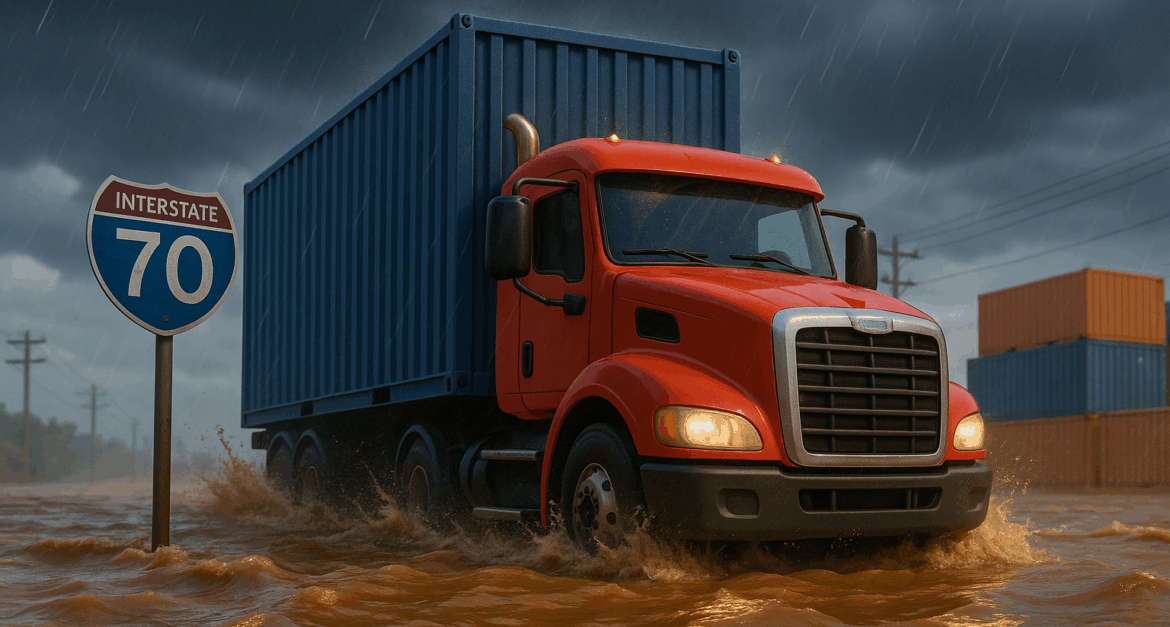
Introduction: Nature’s Disruption Hits the Freight World
The first half of July 2025 has brought with it more than just scorching temperatures and volatile markets—it has unleashed a flooding crisis across large swaths of the United States. From the heart of the Midwest to the Northeastern corridor and stretching down into the Southeast, relentless rainfall and rising rivers have overwhelmed infrastructure, forcing the logistics industry into a full-scale contingency response.
Highways are submerged. Railways are idle. Distribution centers are sandbagged. And yet, freight must move.
At AMB Logistic, we’ve been monitoring and adapting to these disruptions with vigilance. But this isn’t just a temporary inconvenience—it’s a wake-up call for an industry already grappling with infrastructure fatigue, rising shipment volumes, and climate unpredictability.
The Flood Zones: Logistics Under Water
According to the National Weather Service and FEMA updates, the hardest-hit areas this week include:
- Illinois, Ohio, and Pennsylvania: Widespread road closures and power outages have slowed interstate commerce.
- Kentucky and West Virginia: Rail tracks near mining and energy corridors have been rendered inoperable.
- New Jersey and New York suburbs: Last-mile delivery routes have been either cut off or deemed unsafe for operations.
Key Logistics Impacts:
- Freight Delays: OTR carriers report rerouting delays averaging 18–36 hours per load. Some smaller fleets are pausing services in high-risk corridors entirely.
- Warehouse Disruptions: Several Amazon, FedEx, and 3PL facilities have halted fulfillment in low-elevation zones.
- Rail Shutdowns: Norfolk Southern and BNSF issued emergency advisories for cargo rebooking or holding, citing washed-out track infrastructure.
- Last-Mile Chaos: Residential delivery attempts in flooded suburbs have dropped 40%, pushing retail SLAs and e-commerce timelines into red zones.
Real-Time Reactions: What Carriers and Shippers Are Doing
Freight’s survival in this storm hinges on agility. And the most prepared logistics operators have moved quickly.
Dynamic Routing:
Many fleet management systems have updated real-time geofencing and detour protocols. TMS platforms now prioritize flood-safe corridors through Missouri, Arkansas, and Western Pennsylvania.
Driver Safety Protocols:
Major carriers have reissued safety SOPs, suspended night-time driving in red-alert counties, and introduced temporary hazard pay for select zones.
Emergency Shipments:
AMB Logistic, along with other mission-critical carriers, has aligned with FEMA’s supply routing to expedite medical, fuel, and food deliveries.
Surcharges and Buffer Time:
Expect added fees and extended delivery windows in affected regions. Transparency in freight quoting is key during this period.
Infrastructure Weak Points: A National Logistics Liability
This week’s crisis didn’t emerge in isolation. It merely exposed vulnerabilities that have existed for decades:
- Aging Roadways: Many state highways lack proper stormwater infrastructure, making them prone to long closures.
- Floodplain Warehousing: Cheaper real estate in flood-prone zones has led to avoidable facility shutdowns.
- Limited Rail Flexibility: Detours in rail freight require days—not hours—of planning, unlike their truckload counterparts.
For logistics planners, this is not just a tactical detour—it’s a strategic inflection point.
AMB Logistic’s Response: Resilience in Action
At AMB Logistic, we activated our Weather Resilience Command Protocol early this month, ensuring proactive response across client lanes.
- Rerouting Algorithms: Our AI-powered routing engine now deprioritizes all active and predicted flood zones using NOAA and real-time Waze/Geotab integrations.
- Partner Coordination: We’ve been in direct contact with load boards, brokers, and intermodal hubs to flag at-risk freight before it even enters the network.
- Client Notifications: Every customer affected has received tailored ETA updates, surcharge breakdowns, and options for rescheduling or re-routing.
This isn’t about just surviving the storm—it’s about redefining freight resilience.
Looking Ahead: What the Industry Must Learn
The message from this month’s floods is clear: the American logistics engine must evolve, or it will continue to stall under pressure.
Industry-Wide Considerations:
- Climate-Resilient Warehousing: Build distribution centers at higher elevation and with watertight standards.
- Dynamic SLAs: Create flexible delivery agreements that reflect real-world disruptions, not just spreadsheet logic.
- Federal Infrastructure Support: Push for policy that funds flood-resistant freight corridors and upgrades water runoff systems near major interstates and railyards.
AMB Logistic is already incorporating these learnings into our 2025–2026 infrastructure roadmap.
Final Mile: The Road May Be Wet, But It’s Still Ours to Lead
This week’s events have tested every mile, mode, and moment in U.S. logistics. But challenges like these reveal the true strength of a freight network—not just its speed, but its resilience.
To every driver rerouted, every dispatcher recalibrating, and every client who trusts us: thank you.
At AMB Logistic, we don’t just deliver freight—we navigate uncertainty. And we do it with precision, safety, and a fierce commitment to innovation.
Because no matter how hard it rains, the supply chain doesn’t stop—and neither do we.
Contact AMB Logistic
📧 info@amblogistic.us
🌐 www.amblogistic.us
📞 +1 (888) 538-6433
Tags: U.S. Flooding, Freight Disruptions, Climate-Resilient Logistics, Last-Mile Delivery, AMB Logistic, Disaster Response, TMS, Route Optimization, Rail Shutdowns, FEMA Freight, DAT Network




